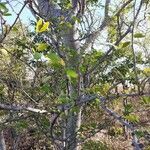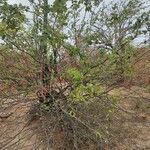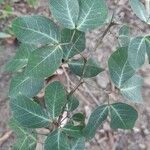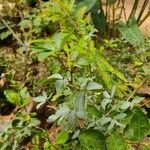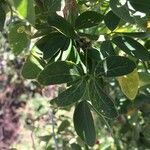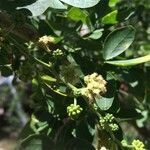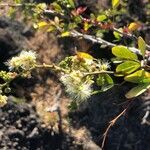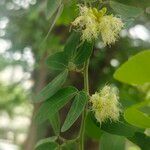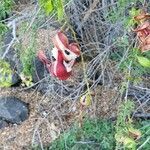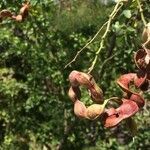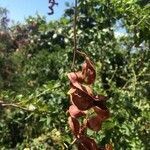Shrub or tree 4–15 m. high, armed with spinescent stipules up to 12 mm. long.. Bark smooth.. Young branchlets puberulous to pubescent.. Leaves: petiole 0.3–2.8(–5) cm. long, glandular at apex at the junction of the single pair of pinnae; leaflets 1 pair, ± asymmetrically elliptic to obovate-elliptic, mostly 0.7–5 cm. long, 0.3–2.3 cm. wide, glabrous or inconspicuously hairy, rounded or emarginate to subacute at apex.. Flowers creamy or yellow, in small heads 0.8–1 cm. wide on short peduncles arranged racemosely or paniculately in ± leafless inflorescences.. Calyx 1–1.5 mm. long, puberulous.. Corolla 3–4.5 mm. long, puberulous.. Free part of stamen-filaments about 6.5–7 mm. long.. Pods spirally twisted.. Seeds black, glossy, 9–10 mm. long, 7–8 mm. wide, covered with a white to reddish fleshy edible aril.
Trees, evergreen. Branches often pendulous; branchlets armed with spinescent stipules. Pinnae 1 pair; glands at junction of pinnae and leaflets; leaflets sessile, 1 pair per pinna, elliptic or obovate-elliptic, 2-5 × 0.2-2.5 cm, both surfaces glabrous, reticulate veins raised abaxially, base slightly oblique, apex obtuse or emarginate. Inflorescence pedunculate heads, aggregated in terminal panicles. Calyx funnel-shaped, 1-1.5 mm, tomentose. Corolla ca. 6 mm. Stamens numerous, connate into a tube at base. Legume blackish brown, curved into a circle, flat, 5-7 cm in diam. Seeds dark brown, shiny, ovoid-ellipsoid, ca. 1.5 cm, hard, with pleurogram. Fl. Mar-Jun, fr. Jul. 2n = 26.
A shrub or small tree. It grows up to 10 m tall but can be 15-25 m tall. The trunk can be 50-60 cm across. There are many branches. The branches are spiny. These are in pairs and are 4-10 mm long. The young leaves are usually reddish. The leaves are twice compound with four leaflets. There is a small spine between the leaflets. The flowers are greenish white in rounded dense heads about 1 cm across. The pods are often twisted spirally. They are 10 to 18 cm long and red when ripe. They are about 1 cm wide and contain 6 to 8 black shiny seeds surrounded by a white to red fleshy aril or pulp. The seeds are flattened and 9 mm long by 7 mm wide and 2 mm thick.
